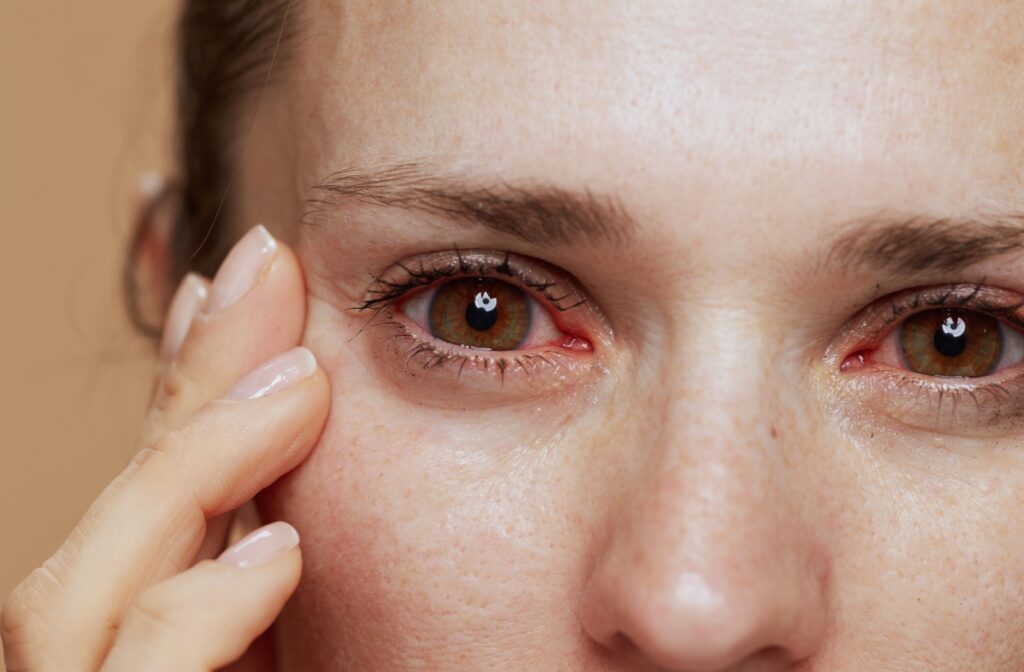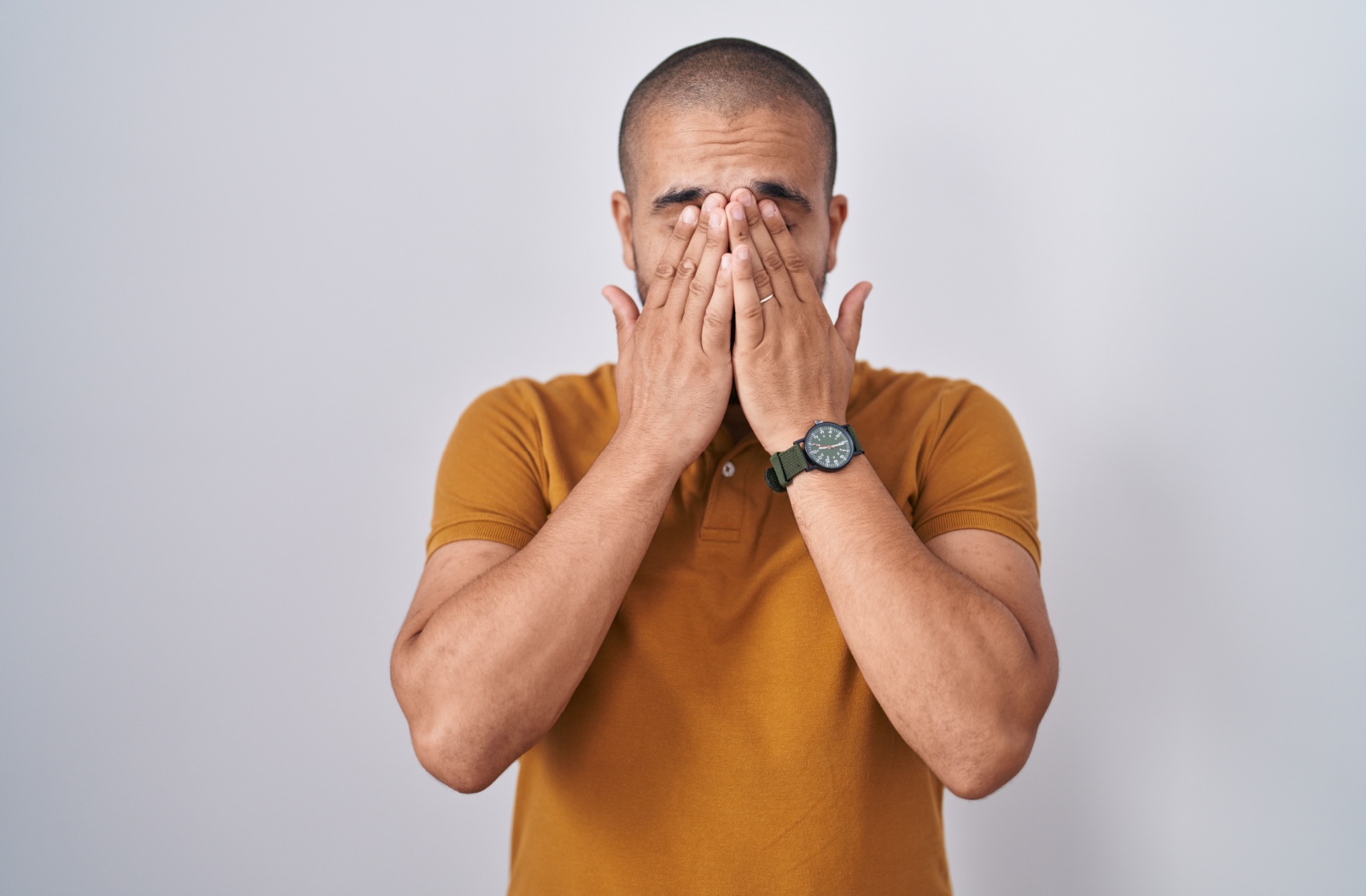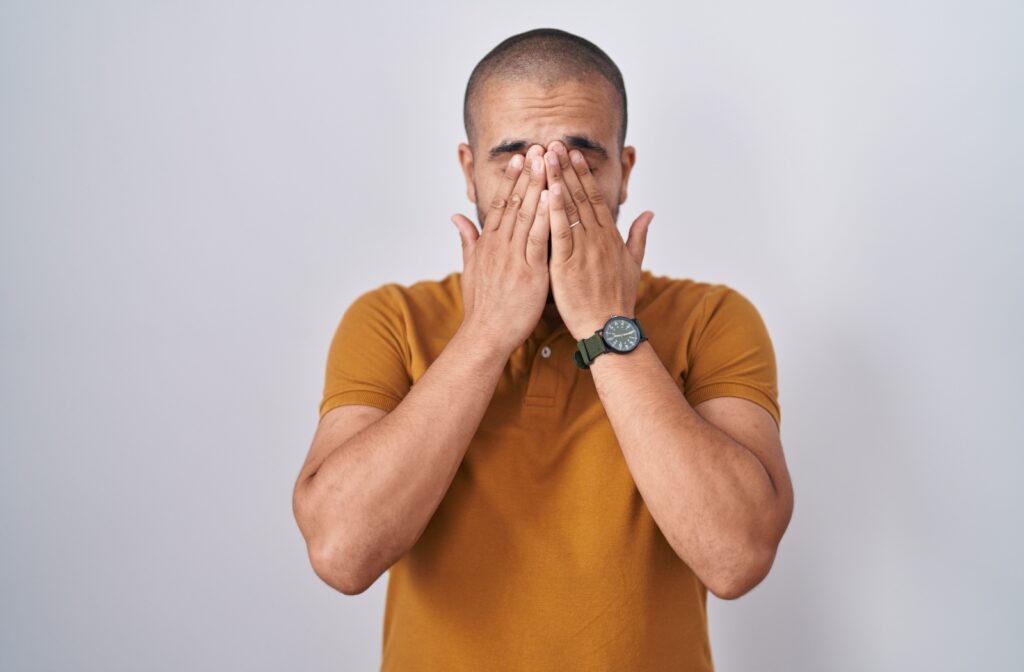Allergies can turn a cozy evening or a beautiful day into a frustrating cycle of rubbing your eyes, reaching for tissues, and wondering why your vision feels off.
Yes, allergies can cause dry eyes—and it’s more than just annoying. While dry eye and allergy symptoms may seem minor at first, they can impact how you see, how your eyes feel, and even how well you sleep.
Whether it’s pesky pet dander, tiny dust mites, or something floating in the air, understanding how allergies and your eye health are connected—and getting regular eye checkups—is key to maintaining comfortable, clear vision.
What Is Dry Eye?
Dry eye is a common condition that affects millions of people. Dry eye happens when your eyes don’t produce enough tears—or the tears they produce aren’t working the way they should.
Your eyes need a constant, consistent layer of tears—the tear film—to keep the eyes nourished and moist. Your tear film may seem simple, but it’s made of 3 essential layers:
- The watery layer keeps the eye hydrated & flushes out debris
- The mucus layer helps tears stick to the eye’s surface
- The oily layer slows evaporation & keeps your tears from drying out too quickly
Your eyes feel comfortable and clear when these layers are healthy and balanced. But when even one layer is compromised, you may experience symptoms like:
- Blurry vision
- A scratchy or gritty feeling
- Red, irritated eyes
- Sensitivity to light
- Mucus in or around the eyes
- A burning sensation
- Discomfort when wearing contact lenses
- Excessive tearing (yes—watery eyes can signify dryness!)
From increased screen time and environmental factors to medications, age, and diet, there are several reasons why tear production can be disrupted.
While mild dry eye may be manageable, it shouldn’t be ignored. Left untreated, it can increase your risk of eye infections or lead to corneal damage over time.
Start with Preventing Allergic Reactions
Treating symptoms helps alleviate discomfort, but avoiding triggers in the first place can go a long way toward preventing flare-ups. Identifying your allergens—whether they’re seasonal or year-round—is the first step.
Some simple changes can help reduce exposure:
- Keep windows closed during high-pollen seasons
- Avoid using window fans that draw in outdoor allergens
- Wash hands after handling pets or spending time outdoors
- Shower before bed to remove pollen from your skin & hair
- Use allergen-proof pillowcases & wash bedding regularly
- Avoid rubbing your eyes, no matter how itchy they feel
- Wear wraparound sunglasses to protect your eyes outside
Small, consistent habits can help minimize allergic reactions and reduce the likelihood of dry eye symptoms taking over your day.

Treating Eye Allergies
When allergy symptoms strike, your goal is simple: feel better faster. While the allergic reaction may pass, the discomfort of dry, scratchy eyes can linger. One approach is to treat the dryness while managing the underlying allergy.
Here are some tips that can help:
- Use preservative-free artificial tears to hydrate the eyes
- Apply a cold compress to the eyelids to reduce itching and inflammation
- Try the 20-20-20 rule to take regular screen breaks
- Eat a diet rich in omega-3 fatty acids to support eye health
- Use a humidifier to combat dry indoor air, especially during allergy season
Every case of allergic dry eye is unique, and treatment should be tailored to your symptoms and lifestyle. That’s why it’s worth seeing your optometrist—they can assess your tear film, identify potential triggers, and recommend a personalized plan.
How Allergies Affect Your Eyes
Eye allergies are caused by allergens—everyday substances that are harmless to most people. But for some of us, allergens can trigger a chain of reactions when our body’s natural defense system gets a little overexcited.
When your immune system encounters allergens like pollen, pet dander, or dust mites, it may release histamine, leading to inflammation in different parts of your body—including your eyes.
The inflammation can interfere with the glands in your eyelids that produce tears, ultimately disrupting your tear film and leaving your eyes feeling dry and irritated.
Your body’s attempt to fix the issue—like overproducing tears—can leave your eyes watering excessively without relief.
Eye allergies can cause a variety of symptoms, including some that overlap with dry eye symptoms, including:
- Itchy, scratchy, or burning sensations
- Swelling of the conjunctiva or eyelids
- Watery eyes or clear discharge
- Redness
- Light sensitivity
- A sensation like there’s something in your eye
Eye allergy symptoms may also occur alongside the usual sneezing, sniffling, and stuffy nose linked to nasal allergies.
Can Antihistamines Make Dry Eyes Worse?
Antihistamines are a go-to remedy for allergy symptoms like sneezing, itchiness, and congestion. However, some antihistamine eye drops used to manage eye allergies can worsen dry eye symptoms, particularly if you’re prone to dryness.
The good news? There are ways to counteract this effect. Preservative-free artificial tears can help restore moisture, and some patients may benefit from switching to allergy eye drops with fewer drying side effects.
Your eye doctor is equipped to help you manage these symptoms and find the right eye drop for what you need.
Get Relief for Your Eye Discomfort
Allergies and dry eye can disrupt your day, but you don’t have to manage scratchy, irritated eyes alone. With targeted care, you can return to clearer, comfortable vision—whether you’re enjoying the outdoors on a summer day or relaxing with your pet on the couch. At The Eye Avenue in Oviedo, our local team of optometrists and eye care professionals works together to provide thoughtful, personalized care. Comfortable days are closer than you think. Book your appointment today.




